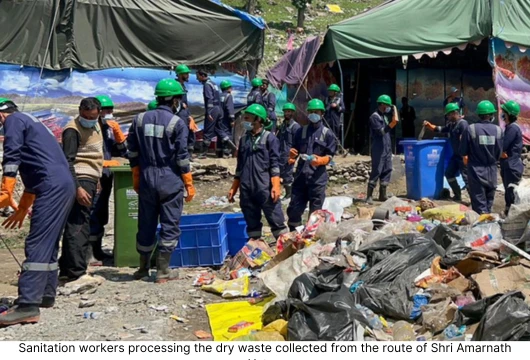Amarnath Yatra Embraces Eco-Conscious Initiatives for a Cleaner Pilgrimage
The sacred Amarnath Yatra, which annually attracts thousands of devotees to the holy cave in South Kashmir, has taken a major step toward sustainability. In recent years, the pilgrimage has witnessed a significant transformation as it integrates eco-conscious practices, aiming to minimize the environmental impact of the floating population. Under the Swachh Bharat Mission Urban 2.0, the Yatra has become a model for eco-friendly waste management, enhanced sanitation, and responsible waste disposal.
Given the number of devotees visiting the site between July and August each year, waste generation has been a significant challenge. However, with the introduction of effective waste management strategies, the Yatra has not only improved the experience for pilgrims but also contributed to preserving the environment around the pilgrimage route.
Eco-Conscious Waste Management at Amarnath Yatra
One key aspect of this eco-conscious transformation has been the implementation of robust waste management systems. The Urban Local Bodies (ULBs) tasked with maintaining cleanliness along the Yatra route have adopted a proactive approach by installing facilities and deploying dedicated resources to handle the large volume of waste generated during the pilgrimage.
In 2022, the ULBs installed and maintained 127 toilet seats, 119 urinals, and 40 bathing units, addressing the critical need for improved sanitation. Additionally, 780 toilets were maintained throughout the route to ensure pilgrims had access to hygienic facilities. These measures drastically reduced littering and open defecation, which had been common in previous years.
To tackle waste disposal, 145 twin bins were placed strategically along the route to encourage waste segregation. These bins helped separate dry and wet waste, making it easier to manage and process. For example, nearly 150 metric tons of wet waste, 130 metric tons of dry waste, and 10-12 metric tons of plastic waste were collected during the Yatra in 2022 alone. This system facilitated effective waste collection and supported recycling efforts by preventing contamination of recyclable materials.
Moreover, ten twin-compartment vehicles were employed daily to ensure 100% waste collection. This commitment to waste management extended to sanitary waste disposal, with black dustbins placed in female toilet facilities for proper disposal. The ULBs’ efforts ensured that waste collection, transportation, and disposal were conducted efficiently and in an eco-friendly manner.
Sanitation and Public Health: Enhancing the Pilgrimage Experience
Sanitation has long been a focal point for improving the pilgrimage experience, and the 2022 Yatra saw a concerted effort to maintain cleanliness at all camps and lodging areas. In addition to waste management, the deployment of 231 sanitation workers helped maintain hygienic conditions at lodging facilities, roads, and public establishments. These workers were equipped with uniforms, PPE kits, gloves, gum boots, masks, and brooms to ensure safety and efficiency in their work.
One of the most remarkable developments in this year’s Yatra was the installation of QR codes at toilets, langars, and camp facilities. These QR codes enabled pilgrims to provide real-time feedback on the cleanliness of the facilities, empowering the authorities to act swiftly on issues. This tech-enabled feedback loop ensured that any shortcomings in sanitation were addressed promptly, contributing to a better experience for Yatris.
Another innovative addition to the Yatra was installing selfie points at critical locations. These selfie points served as interactive spaces where pilgrims could capture memories of their journey, adding a layer of engagement to their experience. These unique spots also played a role in spreading awareness about cleanliness and the importance of responsible waste disposal, as yatris were encouraged to share their eco-conscious journey on social media.
The Role of Swachhagrahis and Solid Waste Management Facilities
One of the primary drivers of this eco-conscious transformation was the involvement of Swachhagrahis, volunteers dedicated to promoting cleanliness and sustainable practices. Under the TULIP (The Urban Learning Internship Programme), these Swachhagrahis worked tirelessly to monitor overall cleanliness in lodging areas, facilitate solid waste collection and segregation, and discourage the use of single-use plastics (SUPs). Their efforts significantly raised awareness among yatris about maintaining a clean and green environment.
To further bolster these efforts, 14 de-sludging vehicles were deployed daily to manage septage from toilet facilities, with additional cars on standby for emergencies. In total, 2,596 kiloliters of septage were dislodged and disposed of, preventing any adverse impact on public health or the environment.
As part of a broader initiative to ensure efficient waste processing, nine solid waste management facilities were inaugurated on May 12, 2023, in ten ULBs across Jammu and Kashmir; notably, three ULBs—Qazigund, Sumbal, and Ganderbal—along the Yatra route. These facilities, equipped with Material Recovery Facilities for segregating dry waste, including bailing and shredding capabilities, and compost pits for wet waste, are designed to process 40 tons daily.
Sustainable Pilgrimage for a Cleaner Future
The eco-conscious practices implemented during the Amarnath Yatra benefit pilgrims, the local environment, and communities. The efforts to ensure waste segregation, sanitation, and the reduction of single-use plastics align with broader environmental goals, such as reducing plastic pollution and protecting natural ecosystems.
The sustainability and waste management focus reflects India’s commitment to promoting eco-friendly tourism and preserving its cultural and religious heritage sites. The measures taken during the Yatra under the Swachh Bharat Mission Urban 2.0 are a clear example of how responsible tourism can be achieved without compromising the sanctity of sacred sites.
As the pilgrimage continues to evolve, it sets a shining example for other large-scale events and religious gatherings in India and worldwide. By integrating eco-conscious practices, the Amarnath Yatra provides a cleaner and more organized experience for its pilgrims and takes a significant step toward preserving the environment for future generations.
With a strong emphasis on waste management, sanitation, and sustainability, the Amarnath Yatra is on a path to becoming a model of eco-conscious pilgrimage, where faith and environmental stewardship go hand in hand.
For more in-depth analysis and inspiring climate news, click here.

